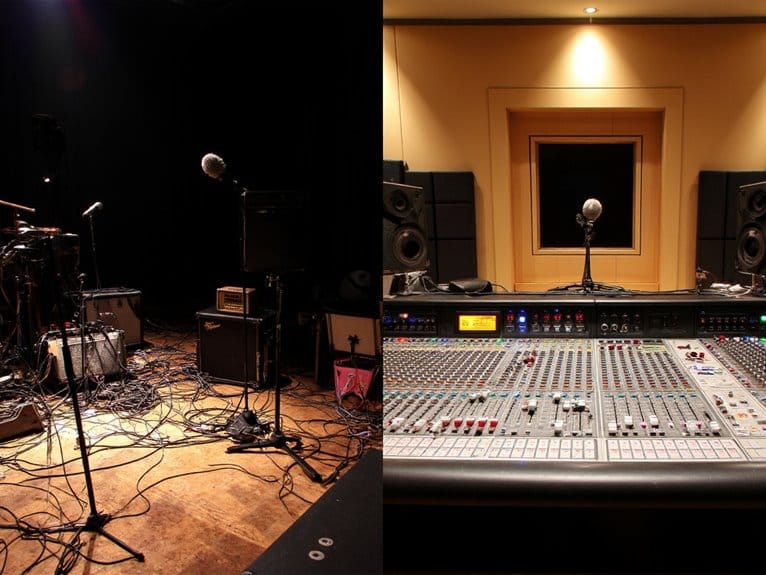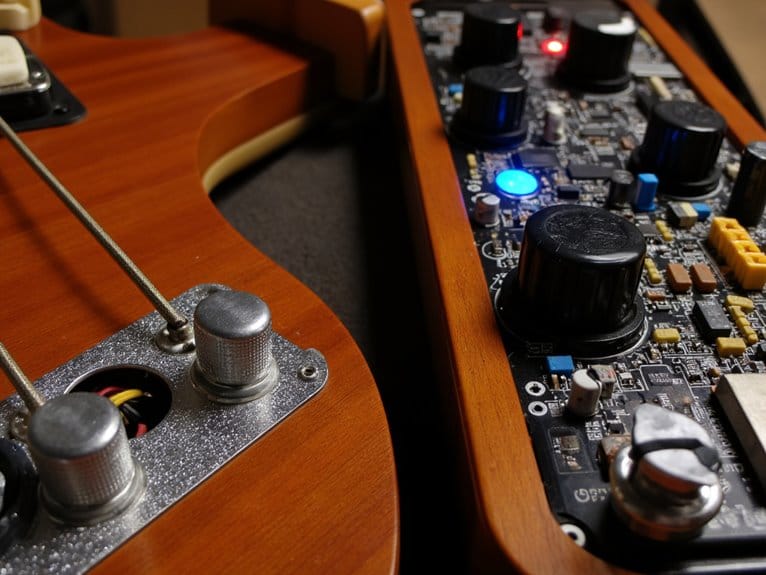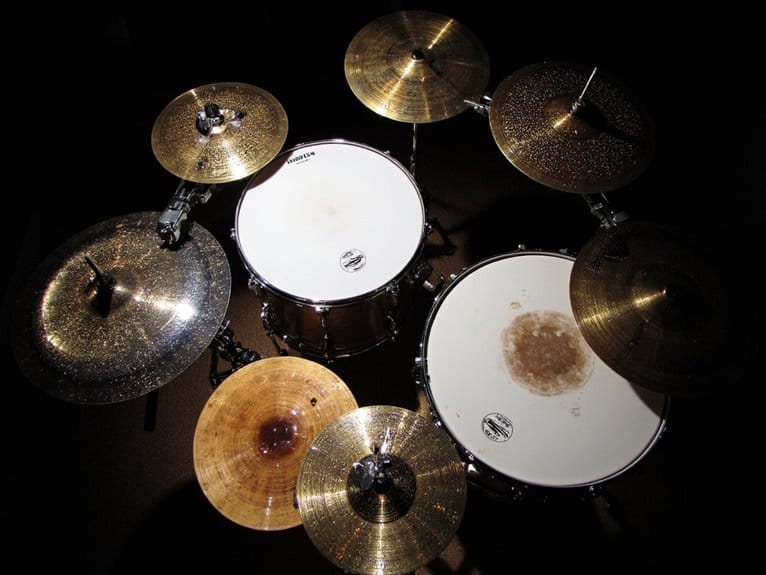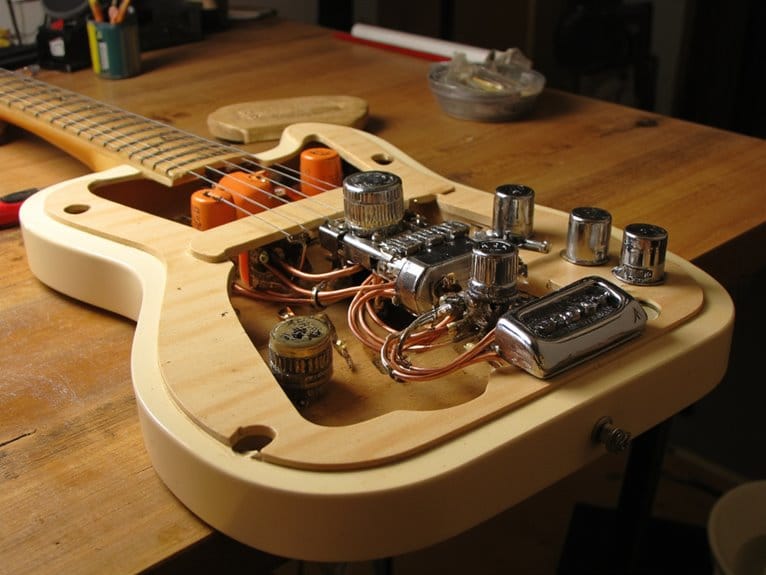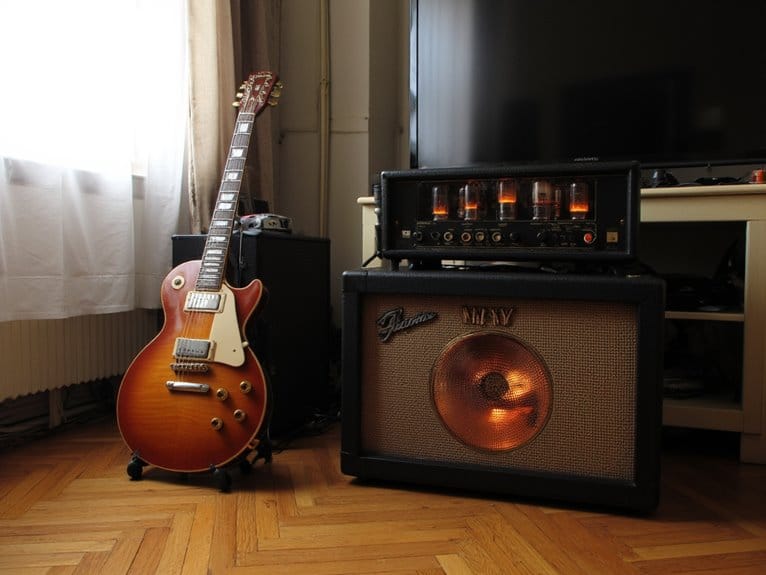Live Performance Setup Vs Studio Recording Setup
You’ll encounter fundamentally different priorities when comparing live performance and studio recording setups, where live configurations emphasize audience coverage through dynamic microphones and portable PA systems that prevent feedback, while studio environments prioritize pristine capture quality using sensitive condenser mics within acoustically treated rooms. Live mixing demands real-time adjustments and error recovery, whereas studio workflows allow multitrack recording with extensive post-production correction capabilities, creating distinct approaches that optimize for spontaneous energy versus technical perfection.
We are supported by our audience. When you purchase through links on our site, we may earn an affiliate commission, at no extra cost for you. Learn more.
Notable Insights
- Live setups prioritize audience coverage and feedback control, while studio setups focus on precise sound capture and minimal distortion.
- Dynamic microphones excel in live environments for durability, whereas condenser microphones dominate studios for superior frequency response.
- Live performances require real-time mixing decisions and immediate error management, while studios allow extended mixing and post-production corrections.
- Venue acoustics present unpredictable challenges, while studios benefit from controlled environments with specialized acoustic treatments.
- Live shows embrace authentic energy and controlled imperfection, while studio recordings demand pristine execution and polished final products.
Sound Reinforcement Goals Vs Capture Quality Objectives
When you’re setting up audio equipment, the fundamental difference between live performance and studio recording lies in what you’re actually trying to accomplish with your sound.
In live reinforcement, you’re amplifying and balancing acoustic and electric sounds to guarantee your audience hears adequately across a large space, prioritizing coverage and feedback control over pristine sound fidelity.
Studio recording, however, focuses on faithfully capturing your sound source with clarity and minimal distortion, creating recordings suitable for production use. Professional studio interfaces typically feature high-resolution converters capable of 24-bit/192 kHz recording to ensure maximum fidelity during the capture process.
While reinforcement compensates for venue characteristics and handles dynamic volume levels for immediate audience perception, studio setups rely on controlled environments with precise microphone placement to minimize room coloration and optimize capture quality for later detailed processing.
Live setups typically utilize mixers for their hands-on control interfaces with knobs and sliders that enable instant adjustments during performance, while studio environments favor audio interfaces that excel at converting analog signals to digital data for seamless DAW integration.
Venue Acoustics Vs Controlled Studio Environment
When you’re setting up audio equipment, you’ll quickly discover that venue acoustics present unpredictable challenges that can make or break your sound quality.
From excessive reverberation in glass-walled spaces to dead zones created by irregular room shapes and materials, I’ve learned that studios gain their major advantage through deliberate acoustic treatment benefits.
This includes strategically placed absorption panels, diffusers, and isolation techniques that create the neutral, controlled environment necessary for precise audio capture and mixing.
The difference becomes especially apparent when you consider environmental noise control since venues battle everything from HVAC systems to traffic noise, while studios eliminate these variables entirely.
Understanding microphone self-noise becomes crucial in these controlled environments, as studio conditions allow you to work with more sensitive equipment that would otherwise pick up unwanted background interference in live venues.
This allows you to focus on pure sound quality rather than fighting against unpredictable acoustic interference.
Professional studio monitors require flat frequency response to accurately reproduce sound in these controlled environments, ensuring that your mixes translate consistently across different playback systems.
Unpredictable Venue Challenges
Unlike the predictable, controlled environment I’ve grown accustomed to in studio work, live venues present a chaotic array of acoustic challenges that can make or break a performance before you’ve even plugged in your first cable.
Every venue’s acoustics are unpredictable nightmares, with sound levels varying wildly across audience areas and potential audience exposure reaching dangerous peaks near subwoofer systems.
I’ve encountered three primary acoustic chaos factors:
- Spatial variation – Sound levels can differ by over 20 dBA within the same venue
- Reflective surfaces – Hard walls create uncontrolled echoes and muddiness
- External interference – HVAC systems and ambient noise disrupt clarity
These variables destroy your carefully planned mixes, forcing real-time adaptations that studios never require, while regulatory constraints add pressure you’ll never face in controlled recording environments.
Acoustic Treatment Benefits
While unpredictable venue challenges can destroy your mix before you’ve even started, proper acoustic treatment transforms these chaotic spaces into controlled environments that rival studio precision, though each serves distinctly different purposes in the audio chain. You’ll notice venue treatments prioritize intelligibility across large audiences using broad-coverage acoustic panel types, while studios focus on monitoring accuracy through precisely positioned elements.
| Aspect | Live Venues | Studios |
|---|---|---|
| Primary Goal | Audience intelligibility | Monitoring precision |
| Panel Placement | Ceiling baffles, wall arrays | Bass traps, broadband absorbers |
| Sound Control | Reverberation reduction | Early reflection elimination |
| Diffusion Focus | Crowd area distribution | Controlled reflections |
| Technology | AI-driven calibration | Modular repositioning |
Sound diffusion techniques vary dramatically—venues employ large-scale distribution elements while studios utilize carefully calculated reflection patterns for neutral monitoring environments.
Environmental Noise Control
Environmental noise control represents the fundamental battleground where live venues and studios wage completely different wars—I’ve learned that venues fight chaotic acoustic variables in real-time while studios engineer predictable silence from the ground up.
In live settings, you’re constantly battling audience chatter, instrument spill, and unpredictable ambient noise that transforms throughout the performance. Your noise management becomes a high-stakes balancing act between avoiding feedback and maintaining auditory safety for hundreds of people.
Studio sound isolation, however, gives you surgical precision through:
- Controlled acoustic environments with minimal external interference
- Strategic microphone placement without audience variables
- Multiple takes and post-production correction capabilities
Studios eliminate the complexity of multiple audio arrivals from monitors, PA systems, and reflective surfaces that plague live engineers, letting you focus on crafting rather than surviving. While live venues require dynamic microphones that can handle high sound pressure levels and reject ambient noise, studios offer the luxury of choosing sensitive condensers for detail capture without environmental interference.
Portable PA Systems Vs High-End Studio Monitors
When you’re choosing between portable PA systems and high-end studio monitors, you’re basically deciding between two fundamentally different philosophies of sound reproduction, each engineered with distinct priorities that’ll dramatically impact your audio experience.
PA systems excel in portability features, offering quick setup and transportation for live events, but they sacrifice sound quality through frequency cuts and nasal coloration that prioritize volume over accuracy.
Studio monitors deliver flat, uncolored frequency response that reveals every subtle nuance in your mix, though they’re designed as stationary near-field speakers optimized for controlled environments within a few feet. Quality studio monitors typically feature 24-bit DACs and carbon fiber drivers to achieve this precise frequency reproduction across the entire audible spectrum.
While PA speakers handle high volumes and extended use without damage, studio monitors focus on precision at moderate levels, making each suited for completely different applications in your audio journey.
Professional studio monitors feature balanced XLR and TRS inputs to ensure minimal signal degradation, while portable PA systems typically rely on basic connections that may compromise signal integrity during live performances.
Real-Time Mixing Vs Multi-Track Recording Workflows
Beyond the hardware differences between PA systems and studio monitors lies an equally fundamental distinction in how you approach the actual recording process, and honestly, this is where things get really interesting from a workflow perspective.
The real magic happens not in your gear choices, but in how those choices fundamentally reshape your entire creative workflow.
When you’re working with real time dynamics during live sessions, you’re fundamentally committing to permanent decisions as the performance unfolds, requiring immediate adjustments that can’t be undone later.
Conversely, multitrack flexibility offers you the luxury of capturing isolated channels that can be manipulated extensively during post-production.
The core workflow differences break down into three critical areas:
- Error correction capabilities – live mixes require complete retakes versus multitrack punch-ins
- Scheduling flexibility – simultaneous presence versus independent recording sessions
- Creative control timing – immediate decisions versus extended mixing periods
Both setups benefit from understanding latency issues during live monitoring, as this affects real-time performance quality and the performer’s ability to stay synchronized with backing tracks or other musicians.
Studio recording workflows also require proper monitoring headphones with frequency response ranges of 20 Hz to 20 kHz to ensure accurate audio reproduction during the tracking process.
Microphone Selection for Stage Vs Studio Applications
Three fundamental microphone types define the performance versus studio recording divide, and I’ve learned through countless sessions that choosing the wrong type for your environment can completely derail an otherwise solid recording or live performance.
Dynamic mics excel on stage because they’re virtually indestructible, require no phantom power, and feature cardioid polar patterns that provide excellent feedback rejection when you’re dealing with monitor wedges and loud stages.
Condenser mics dominate studio applications due to their superior frequency response and studio precision, capturing subtle vocal nuances that dynamic mics simply can’t match. Their ability to handle high SPLs without distortion makes them particularly valuable in controlled recording environments.
The sound quality difference is remarkable – condensers deliver that professional studio sheen, while dynamics prioritize durability over ultra-high fidelity, making each microphone type perfectly suited for its intended environment.
Industry-standard models like the Shure SM58 exemplify this live performance philosophy with their rugged construction and vocal clarity specifically tailored for enhanced performance in demanding stage environments.
Monitor Systems and Performer Feedback Management
Monitor systems represent the most critical difference between live and studio environments, and I’ve watched more performances crash from poor monitoring than from almost any other technical failure.
Your live setup demands dynamic range control and strategic positioning to prevent feedback, while studio monitors prioritize accurate sound representation for precise mixing decisions.
The monitor specifications you’ll need vary dramatically between environments:
- Live Performance: Wedge monitors or in-ear systems with feedback suppression and custom performer mixes
- Studio Recording: Near-field monitors with wide frequency response and minimal room reflection interference
- Sound Calibration: Live setups focus on clarity and feedback prevention, studios emphasize precision across full frequency ranges
I’ve learned that proper sound calibration makes the difference between professional results and amateur headaches, regardless of your environment’s complexity.
Modern in-ear monitor systems offer superior noise isolation capabilities of up to 38 dB, providing performers with clear sound while blocking ambient stage noise that can interfere with their performance.
Studio monitoring requires interfaces with zero-latency monitoring features to eliminate the delay that can disrupt performer timing during recording sessions.
Console Requirements and Routing Differences
Your console choice fundamentally shapes every aspect of your audio workflow, and I’ve discovered that the routing differences between live and studio boards create entirely different approaches to signal management. Console portability remains essential for touring, where road cases protect your investment during constant transport, while studio installations prioritize extensive routing capabilities over mobility concerns.
| Live Console Focus | Studio Console Focus |
|---|---|
| Quick setup/teardown | Precise channel control |
| Multiple monitor sends | Extensive effect returns |
| FOH/monitor optimization | Multitrack recording outputs |
| Manual real-time control | Advanced automation systems |
Routing complexity separates these environments dramatically—studios demand elaborate patch bays and direct outs for multitrack recording, while live consoles streamline signal paths for immediate performance needs without unnecessary processing overhead. Digital mixers offer greater flexibility with advanced features that benefit both environments, though they require more training compared to their analog counterparts with straightforward design approaches. Professional setups in both environments require balanced connections for microphone inputs to ensure superior signal integrity and eliminate electromagnetic interference over longer cable runs.
Equipment Durability Vs Precision Engineering
Beyond routing considerations, I’ve learned that the fundamental engineering philosophies driving live and studio equipment couldn’t be more different—one prioritizes survival under brutal conditions, while the other obsesses over sonic perfection in controlled environments.
When you’re choosing gear, durability concerns dominate live setups because equipment faces constant transport, temperature changes, and rough handling. You’ll notice larger passive speakers designed for punishing volume levels, while studios favor smaller active monitors engineered for flat frequency response.
The precision trade offs become clear when comparing microphones—live performers rely on virtually indestructible dynamic mics like the SM58, whereas studios employ delicate condensers that capture nuanced tonal qualities. Dynamic microphones also excel at rejecting background noise, making them particularly valuable in challenging acoustic environments.
Consider these key engineering priorities:
- Live gear emphasizes impact resistance and environmental protection
- Studio equipment prioritizes signal accuracy and minimal coloration
- Maintenance schedules differ dramatically between harsh touring conditions and climate-controlled rooms
Dynamic microphones excel in live environments due to their ability to handle high SPL without distortion, while their robust construction withstands the physical demands of touring.
One-Take Performance Vs Multiple Recording Sessions
While equipment differences reveal the clash between ruggedness and precision, the performance approach itself creates an even deeper philosophical divide between capturing lightning in a bottle versus methodically crafting perfection.
One take spontaneity delivers that raw, unfiltered energy you feel at live shows, but it’s terrifying when mistakes become permanent. Multiple take flexibility gives you creative options and safety nets, though you might lose that magical first-attempt spark.
| Aspect | One-Take | Multiple Takes |
|---|---|---|
| Energy | Cohesive, authentic | Potentially fragmented |
| Risk | High error potential | Correctable mistakes |
| Time | Fast recording, more rehearsal | Longer sessions, less prep |
| Cost | Potentially expensive re-dos | Long-term efficiency |
| Psychology | High pressure, anxiety | Relaxed, experimental |
I’ve found that choosing between these approaches often depends on whether you’re chasing that perfect live moment or building something meticulously crafted.
Audience Interaction Vs Isolated Track Creation
The moment you step from a controlled studio booth into the blazing lights of a live stage, you’re trading the surgical precision of isolated track creation for the unpredictable energy exchange that happens when hundreds of strangers become your creative collaborators.
In studio recording, you’ll work within separate booths designed for sound isolation, allowing multiple takes without external interference.
Live performance demands open-stage designs that facilitate visibility and real-time communication with your audience.
Here are three essential audience engagement strategies:
- Call-and-response methods that prompt vocal participation
- Interactive stagecraft involving crowd movement and props
- Social media integration with branded hashtags
Your interactive performance techniques must account for microphone placement that captures audience reactions, while studio setups prioritize eliminating that same external noise, creating fundamentally different technical requirements for each environment. For live performances, omnidirectional mics excel at capturing audience participation with their 360-degree pickup patterns and ranges extending up to 16 feet, whereas studio cardioid microphones focus on isolating sound from a single direction. Studio environments typically maintain sub-10ms latency to ensure artists can perform naturally in sync with their backing tracks, while live setups often tolerate higher latency due to the physical distance between performers and speakers.
Stage Positioning Vs Booth and Room Design
Once you’ve mastered the art of connecting with your audience, you’ll discover that where you physically position yourself and your equipment becomes just as important as what you’re actually playing.
Your stage layout requires dynamic positioning that adapts to each venue’s unique characteristics, maximizing sound projection while maintaining essential performer interaction.
Strategic spatial arrangement of amplifiers, monitors, and microphones creates acoustic balance that serves both your ears and your audience’s experience.
Unlike studio booth design, which prioritizes isolation and controlled acoustics, your live setup demands venue adaptability and visual impact considerations.
Monitor placement becomes critical for hearing yourself clearly without feedback, while your overall arrangement must facilitate audience engagement and seamless communication between band members throughout the performance.
For vocal capture in challenging live environments, shotgun microphones positioned 3-4 feet from performers can effectively isolate primary audio sources while rejecting ambient venue noise.
Live Error Recovery Vs Post-Production Correction
When something goes wrong during your live performance, you’re dealing with an entirely different beast than when you’re fixing mistakes in post-production.
I’ve learned this lesson the hard way through countless gigs where quick thinking meant the difference between a seamless show and an awkward disaster.
Your real time strategies must prioritize continuity over perfection, relying on error concealment, backup channels, and quick manual adjustments to mask problems instantly.
In live performance, smooth continuity beats flawless execution—embrace quick fixes over perfect solutions when seconds matter most.
Meanwhile, your post production techniques offer unlimited processing power for sophisticated audio restoration processes.
Live error detection methods include:
- Redundant signal paths for instant switching
- Real-time monitoring with automated level adjustments
- Forward error correction protocols for streaming applications
Post-production gives you multitrack editing capabilities, allowing precise pitch correction, noise reduction, and frame interpolation that’s simply impossible during live performance constraints.
Energy and Spontaneity Vs Technical Perfection
When you’re setting up for live performance, you’ll find yourself chasing that electric, unpredictable energy where every note carries the raw emotion of the moment, even if it means accepting the occasional imperfection that makes each show uniquely yours.
In contrast, your studio setup prioritizes meticulous control over every sonic element, allowing you to craft multiple takes, apply precise effects, and achieve that polished perfection that simply isn’t possible when you’re performing in front of a live audience.
This fundamental tension between embracing spontaneous musical moments and pursuing technical excellence shapes every decision you’ll make about your equipment, room treatment, and recording approach.
Raw Performance Energy
Electric guitars crackle through amplifiers, drums thunder with unrestrained power, and vocalists belt out lyrics with raw intensity—there’s something undeniably magnetic about live performance energy that even the most pristine studio recording can’t fully capture.
When you experience live spontaneity, you’re tapping into musical authenticity that studio perfection simply can’t replicate, with organic sounds creating genuine audience immersion.
The performance dynamics of live shows deliver emotional depth through three key elements:
- Unfiltered spontaneous variations that showcase real-time musical decisions
- Interactive experience between performers and crowd energy
- Raw energy transmission through physical presence and acoustic immediacy
You’ll notice how musicians feed off crowd reactions, adjusting their intensity accordingly, while subtle improvisations create unique moments that’ll never happen again exactly the same way.
Studio Precision Control
Studio precision transforms musical mistakes into polished perfection, but you’ll find this technical control comes at the cost of the raw spontaneity that makes live performance so compelling.
The studio environment enables multiple takes and recording techniques that capture performance consistency you simply can’t achieve onstage, where artistic focus shifts from technical perfection to emotional expression.
Sound fidelity reaches remarkable heights through controlled editing processes and production nuances that highlight every musical detail, yet this musician mindset prioritizes accuracy over instinctive creativity.
Take variations allow producers to craft flawless compositions, but the absence of audience energy often leaves performances feeling sterile despite their technical brilliance, creating a fascinating tension between polish and authenticity.
Signal Processing in Real-Time Vs Digital Editing
Although I’ve spent countless hours tweaking both live and studio setups, the fundamental difference between real-time signal processing and digital editing comes down to one critical factor: time.
When you’re running sound live, you’re working with real time algorithms that demand immediate decisions, while studio work lets you leverage offline processing for unlimited tweaking.
Here’s what separates these approaches:
- Live processing requires dedicated DSP hardware optimized for speed and low latency
- Studio editing uses powerful CPUs with complex plugin chains for creative manipulation
- Real-time decisions are irreversible during performance, unlike studio’s retrospective editing freedom
You’ll find live scenarios prioritize subtractive EQ and feedback prevention, whereas studios embrace additive processing and experimental sound sculpting without time constraints.
Final Output Expectations and Quality Standards
Perfection becomes the dividing line between what you’ll accept from a studio recording versus a live performance, and I’ve learned that these opposing quality standards fundamentally shape every technical decision you’ll make in each environment.
Your studio work demands pristine execution, capturing every subtle detail through multiple takes, overdubs, and digital corrections that create a polished product listeners will analyze repeatedly.
Meanwhile, your live performances embrace controlled imperfection, where slight timing variations, ambient crowd noise, and spontaneous moments enhance listener engagement rather than detract from it.
The artistic intention differs dramatically—studios aim for repeatable perfection while live shows prioritize authentic energy and real-time connection, requiring completely different technical approaches to meet these contrasting expectations.
Frequently Asked Questions
What Are the Typical Budget Differences Between Live and Studio Setups?
You’ll find live gear typically costs more upfront, with PA systems ranging from hundreds to thousands depending on venue size, plus ongoing transport and technician fees.
Studio gear offers better long-term value since you’re making a one-time investment of £500-£3,000 for home setups, while professional studio recording hits you with £50-£500 hourly rates that accumulate quickly during extended sessions.
How Do Copyright and Licensing Requirements Differ for Live Versus Recorded Music?
When you’re dealing with live music, you’ll need performance royalties through PROs like ASCAP or BMI, which venues typically handle with blanket licenses based on capacity and frequency.
However, if you’re recording that same performance, you’ll face additional licensing agreements for both the underlying composition and sound recording rights, plus potential legal issues since federal copyright doesn’t directly protect live performances themselves.
Which Setup Offers Better Career Opportunities for Audio Engineers?
You’ll find live performance setups currently offer stronger career prospects than studio recording, with 10% projected job growth driven by festivals, corporate events, and streaming demand.
While studio work provides controlled environments and potentially higher specialized salaries reaching $167,000, live sound engineering delivers more diverse opportunities, travel experiences, and networking potential with artists and promoters, creating sustainable freelance careers.
What Insurance Considerations Apply to Live Equipment Versus Studio Gear?
Your live gear faces higher equipment vulnerability from theft, transport damage, and public exposure, requiring extensive liability coverage for venue accidents and worldwide territorial protection.
Studio equipment needs policy coverage emphasizing fire, flood, and breakdown risks in fixed locations, plus rehearsal space protection.
Live setups demand event-specific cancellation insurance and mandatory venue liability, while studio policies focus on natural disaster coverage and equipment valuation with lower deductibles.
How Do Union Regulations Affect Live Performance Versus Studio Recording Sessions?
Union rights create distinct challenges for you depending on your recording environment, with performance contracts requiring unanimous performer consent for live show recordings.
Meanwhile, studio sessions typically allow promotional filming within 10-minute limits.
You’ll face higher costs with union musicians due to mandatory 3-hour session minimums and strict clearance requirements.
However, studios offer more controlled environments where you can negotiate specific filming clauses compared to live venues’ blanket recording prohibitions.
On a final note
You’ll find that choosing between live and studio setups isn’t about right or wrong, but rather matching your tools to your specific goals. Whether you’re chasing that electric crowd connection or pursuing pristine sonic perfection, each approach demands different gear, skills, and mindset. I’ve learned that understanding these fundamental differences helps you make smarter equipment decisions, set realistic expectations, and ultimately deliver better results for your intended audience and creative vision.

